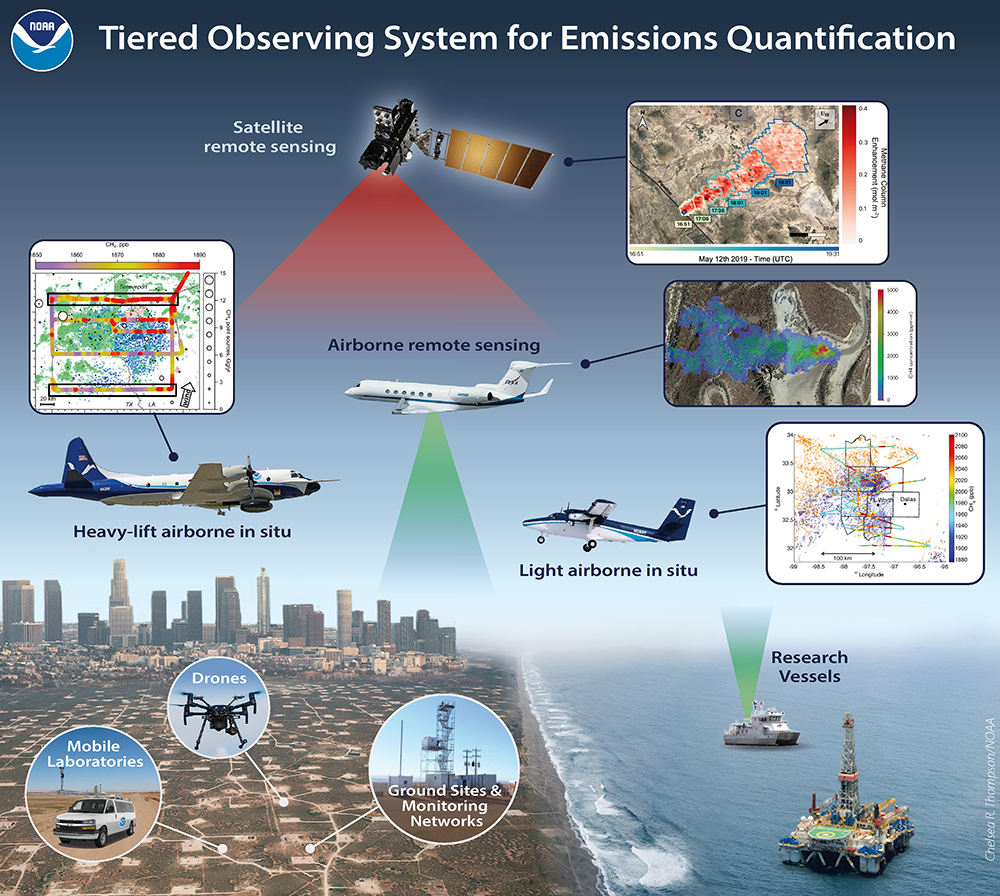
Intensive Airborne Surveys
Long-term monitoring of greenhouse gas (GHG) emissions and air pollutants associated with oil and gas (O&G) production and urban areas requires a comprehensive observing system that is composed of ground monitoring systems as well as airborne and satellite remote sensing systems. The latter are powerful but nascent technologies that need rigorous verification. NOAA airborne surveys and remote sensing approaches represent the currently best-available methodology to validate and augment new remote sensing technology. OAR has developed state-of-the-art research aircraft instrumentation and has a long history in the execution of airborne campaigns. Based on this proven expertise, OAR will derive emissions using airborne surveys involving several detection and analysis methods.
- Mass balance. Described as the "gold standard" for basin scale emissions, mass balance derives emissions from the difference between upwind and downwind trace gas concentrations. NOAA CSL's airborne Doppler lidar, currently deployable on the NOAA Twin Otter aircraft, provides high resolution wind velocities throughout the boundary layer, as well as mixed layer depth, to improve the efficiency and accuracy of this method.
- Tracer relationships. Co-measurements of GHGs with other emitted pollutants provide quantitative emission estimates and source attribution (e.g., agriculture, O&G, urban). NOAA OAR has substantial expertise in developing and deploying airborne instrumentation for a wide range of pollutant species.
- Eddy covariance. Variation of pollutant concentrations with vertical wind velocity provides surface emissions via an independent and complementary method
- Inverse modeling. Application of chemical transport models to satellite, airborne and ground-based GHG measurements provides complementary emission estimates.
Long-term Satellite Observations
Satellite observations augment ground monitoring capability and have become a viable source of information – they are the "eyes in the sky" that provide routine daily observations for long periods of time and thereby provide continuity and trends from regional to global scales. While well calibrated ground-based sensors often provide the most accurate GHG and pollutant measurements, NOAA and its partner agencies use a fleet of geostationary and polar-orbiting satellites to observe emissions from large sources as well as derive concentrations assuming a well-mixed atmosphere. In the last decade, a host of commercial and non-profit methane observing satellites have come into the fore (e.g., GHGSat, MethaneSAT). Civilian and commercial/non-profit satellite instruments serve diverse needs by observing methane emissions from different source sectors. However, detecting and quantifying depends on assumptions that require thorough validation:
- Plume Detection. Averaged over weekly to monthly to yearly time scales, methane concentrations from satellite sensors such as the Sentinel 5 Precursor Tropospheric Monitoring Instrument (S5P TROPOMI) can identify source regions, and observations combined with models provide emissions (fluxes). TROPOMI and similar instruments in a polar orbit measuring in the short-wave and near-infrared spectrum can detect plumes from high-emitting facilities, but plume quantification involves assumptions about local meteorology. By contrast, frequent snapshots of high-emitting plumes observed by geostationary satellite imagers, such as the GOES-R series Advanced Baseline Imager (ABI), can be integrated over time to derive emissions without the need for meteorological data or models. Quantifying plume concentrations and fluxes from remote-sensing data requires an independent source of information.
- 3D Concentration Fields. Hyperspectral sounders measuring in the infrared such as the JPSS (Joint Polar Satellite System) series or MetOp (Meteorological Operational satellite) series sounding instruments (e.g., Cross-track Infrared Sounder) observe 3D fields of methane concentrations but retrievals are useful only on monthly to yearly time scales. These data need to be integrated with other in situ observations and models such as NOAA's CarbonTracker to be converted to fluxes. Prior to converting to fluxes, the data need to be well validated to ensure quality control.
Reference: McDonald, B.C., J. He, C. Harkins, J. de Gouw, N. Elguindi, R. Duren, J. Gilman, E.A. Kort, C.E. Miller, J. Peischl, G. Pétron, and C. Thompson, A Review of U.S. Oil and Gas Methane and Air Pollutant Emissions , in Environmental Magazine, Air and Waste Management Association, (2023).